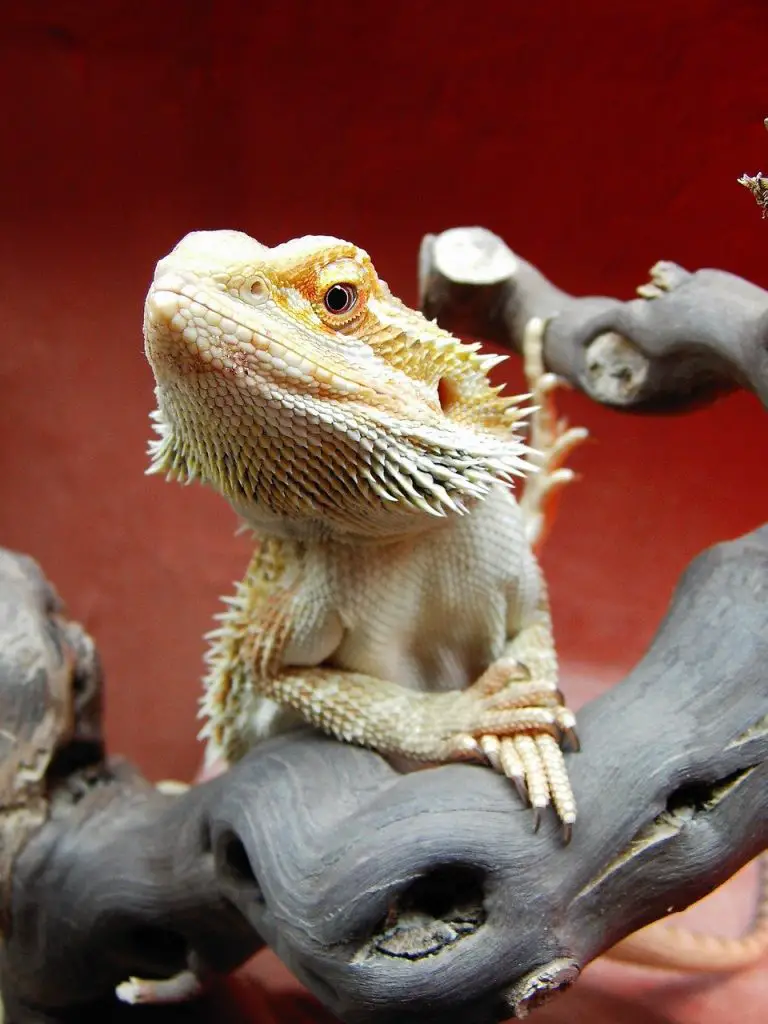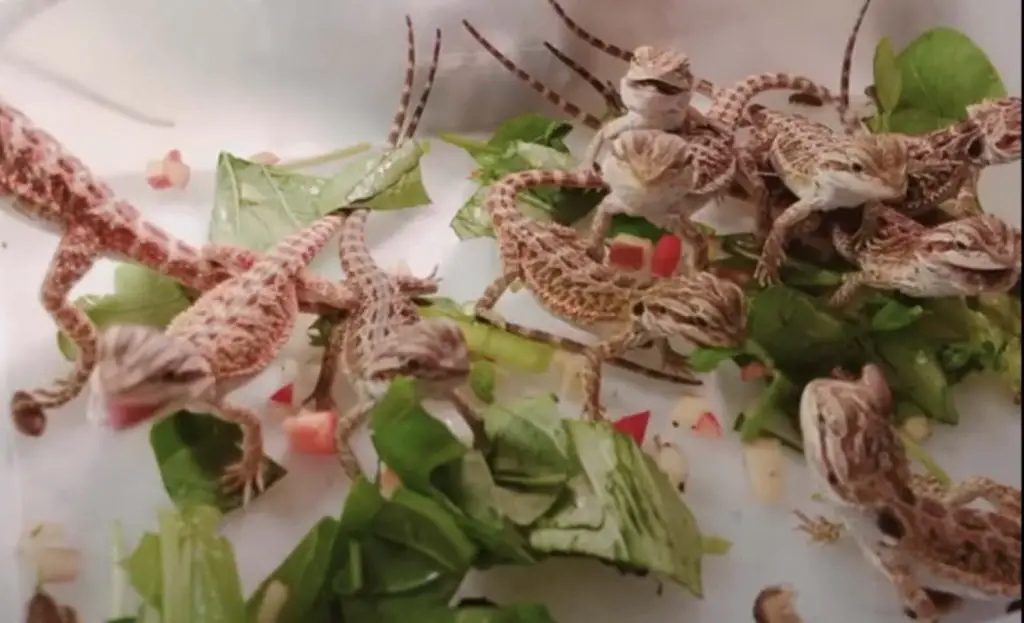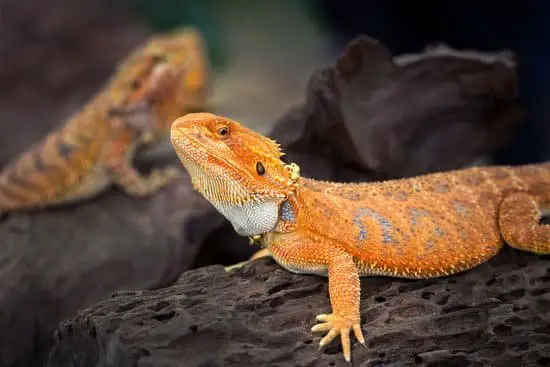One of the easiest and yet most exotic pets that a beginner can own are bearded dragons as pets.
They often called “beardies” because they have what can be described as a beard under their throat.
This is because they come across as loving and friendly to their owners with interesting personalities to boot. However, looking after one (although fairly easy) can be a challenge if you do not know what to do or what they need.
Luckily this article can address all your concerns when it comes to bearded dragons as pets.
Contents
Morphs Of Bearded Dragons You Can Keep As Pets

There are many types of morphs when it comes to bearded dragons. Morphs refer to the type of body (and what patterns) the dragons have. This is a way for pet sellers to describe them to future pet owners.
Morphs come about due to breeding where a baby can gain different traits per parent. The morphs can be categorized into nine groups: Classic/Standard, Translucent, Leatherback, Dunner, Hypomelanistic, German Giant, Witblits, Silkback, Paradox, Zero, and Wero.
Whare Are Bearded Dragons Come From?
These creatures are native to Australia but have managed to find a way into people’s hearts across the seas.
Poisonous
Bearded dragons are not poisonous but their bites and sting. While they are known for being well-tempered, if you annoy them too much they may react as many pets tend to do.
Their bites may lead to infections due to the bacteria they carry. The best is to clean the bite well straight away.
Price Range At Pet Stores
The cost of a bearded dragon all depends on where you buy them. However, they can go from 30 USD up to 100 USD for the big beardies.
Food
Bearded dragons like to eat a mixture of vegetables and insects, or sometimes pink mice, making them omnivores.
When you feed them insects you should make sure that the creatures are fed with a lot of nutrition (known as gut loading) so that these can pass on to your pet.
As for the vegetables you can chop up some fruit and vegetables with leafy greens. You place all of this into a shallow bowl and mix it all together as you would when making a salad.
Plus, you can keep some leafy greens in the enclosure to the side so that the bearded dragon has something to snack on throughout the day or night.
Water
Water is an important part of life. Therefore, you should make sure that you have a bowl of water in the enclosure that you should refill when it is empty.
If your dragon enjoys a deep in the water then you should add a larger bowl that they can use as a mini swimming pool.
Accessories
Last update on 2023-01-02 / Affiliate links / Images from Amazon Product Advertising API
There are many things you can get for your pet bearded dragons nut the most important would be:
Enclosures For Your Pet Bearded Dragons
One of the first things you would want to do if you want to have a bearded dragon as a pet is to make sure the enclosure is ready for them to move into. This can take a lot of investment not only in money but time as well.
You can make the enclosure look like home by adding rocks and caves from them to play with. Plus, adding bowls for their food and water can also help them and you out a lot.
Light
The type of light that is often used during the day in the bearded dragon’s enclosure is UV. This is because this light gives them vitamin D for their skin as well as helps them absorb phosphorus and calcium from food.
The latter is needed to strengthen their bones, their muscle contraction, and make the metabolic processes normal. Without additional calcium, their bodies will draw it from their bones resulting in them becoming weaker.
Plus, they could develop muscle tremors and poor muscle contractions resulting in organ failures.
The temperature inside the enclosure should be on a gradient. One end of the tank should be about 90 Fahrenheit or 32 degrees Celsius while the other end is about 70 Fahrenheit or 21.1 degrees Celsius.
The 90 Fahrenheit area is where they can bask in the UV light as if it is a hot day while the other end is an area that they can cool off in.
Humidity
The humidity in the enclosure should be between 30 and 40 percent. This can also help them to shed their skin so as not to have dead skin over their eyes and toes.
Plus, adding a water bowl for them to slightly splash around in can also help them out.
Substrate
You would need to set up the enclosure and one of the things that you would need to do is to figure out the type of substrate you will be using.
This is known as the material that makes up the floor of the enclosure. The purpose of this is to make the dragon feel more at home. Plus, the substrate can also keep the humidity in the home balanced.
There are different types of substrates and the one that you will use will depend on the age of the dragon.
For Juveniles Pet Bearded Dragons
Young to teenage bearded dragons should not have sand or any type of loose soil as their floor. This is because they could be tempted to eat the sand either out of curiosity or by accident.
Eating sand could result in them developing intestinal problems. Therefore, the best course of action would be to get a reptile carpet or just to use paper towels.
For Adults Pet Bearded Dragons
However, adults can have washed play sand but make sure it is not fine silica sand. You can also line the floor with paper towels or a reptile carpet.
But the sand would be the more natural-looking option since they like to dig and burrow in it for fun. Plus, when “they go” it is easy to scoop up the droppings using a cat litter scoop.
What Not To Use
Items that you should not use as substrates are walnut shells, corn cob, wood shavings, etc. since these can cause many issues if it is swallowed by your pet dragon.
Sickness
Bearded dragons need to be fed well and a lot of vitamins should be added to their food. This is because they could end up suffering from infectious stomatitis (‘mouth rot’), parasites, or respiratory and adenovirus infection.
However, the most common illness is a metabolic bone disease. Therefore, if you see that your pet is sick, you should take them to the vet right away.
Vitamins
A good idea would be to add vitamin D and calcium supplements by lightly dusting these over their meals.
The reason to do this is to prevent metabolic bone disease. You can also dust over their food with multivitamin but you should limit this dust to once a week. There is such a thing as too many vitamins.
Feeding Pet Bearded Dragons
Before you start feeding your dragon you should consult with your vet about how much to feed them per a meal.
The amount of food they should eat depends on how big there are. This also applies to how you would feed an adult bearded dragon.
Speaking to your vet when your dragon grows larger will help you to make sure that you do not overfeed them. You would not want them to develop a weight problem and other health issues.
Feeding Baby Dragons
Human babies eat a lot and many times throughout the day. This is similar to growing bearded dragons since they should be fed three times a day.
You can even add some crickets to the mix but make sure that they are small. To know what size the insects should be is by looking at the distances between the dragon’s eyes. If a bug can if there, the dragon can eat it.

Feeding Adult Bearded Dragons
The diet for adult dragons is slightly different from that of the younger ones. They still eat their leafy greens and vegetables but not you can add more types of insects to their meal.
They can eat different types of worms such as butter worms, super worms, silkworms, wax worms, earthworms, red worms, and even molted mealworms. Plus, you can also add some pink mice to the mix.
Bearded Dragons Smell
What you should always remember is that bearded dragons do not produce any natural smell. Unlike humans, the beardies don’t sweat to regulate the body temperature, instead, they pant and change their body color.
Your beardie may be smelling as a result of absorbing smells from the environment. The smell can come from the feces, dirty enclosure and substrate, leftover food, or due to fungal infection.
When you understand the root cause of your beardie smelling, it is possible to get rid of the smell. No one wants to have a pet that keeps him/her away because of an intolerable smell.
Always ensure that the tank and substrates are clean, remove the remaining food, bath your beardie, and maintain correct humidity. High humidity encourages bacteria problems and bad smell, especially from the high moisture.
Bearded Dragon Diet and Smell
There are so many myths about bearded dragons, and focusing on them can discourage you from keeping the beardies. One of the common myths is where people associate the beardies with bad smell.
Bearded dragons are not smelly; it all depends on your care level. If you keep them clean, use a quality substrate, and make sure everything in the enclosure is clean, there will be no smell.
Leaving the remaining food in the enclosure is always discouraged because the beardie hardly eats it, and it ends up rotting. Rotten foods will not only contribute to a bad smell in the environment but can also be poisonous to your pet.
Also, rotten food encourages the growth of bacteria, which produce stinky gases. Some bearded dragon food like crickets are quite smelly and can be the reason for the smell in the enclosure.
When a diet does not go well with the bearded dragon stomach, it can make the stool smell awful.
Breeding Bearded Dragon In Captivity
It is said that the bearded dragon pet owner should wait until their female and male pets are about 18 months old. If you want to breed your dragons then you should up the calcium supplements and intake for the female.
It would be best to keep the two separated if you wish to control their breeding habits better. This is because they can breed at 8 months since their size is more of a factor than their age.
However, if the female is too small then this may cause some issues such as them becoming egg bound. This can mean that they are too small to lay their eggs or there is no appropriate area to do and therefore, they hold on to them.
Read the full detail about breeding bearded dragon here
The Male’s Mating Call
Once they are ready to mate (and you have all that you need to handle their many offsprings such as having incubators and food) you can put them together and let nature take its course.
The male will show that he wants to mate because his beard will become darker. His mating call is usually him waving his arms, and stomping his feet in view of the female.
However, the most telling tale is that he will rather violently bob his head. If the female is interested then she will indicate with her hand.
From there they mate. The male will latch onto the female by biting her neck, holding her down to get into position. This may look extreme but apparently, the females are really into it.
However, there could be a slight chance that the male bites her skin way too hard, resulting in damage. The mating process is short, taking a few seconds.
Afterward, you can check if the male bites her too hard. To tell if the mating was successful the female will gain a lot of weight.
Incubator/Hatching Bearded Dragon Eggs
The females can store the male’s sperm in their oviductal crypts so that they can use it to lay more batches of eggs.
You should expect at least two batches of eggs and at most about four. The batches can contain from 11 to 30 eggs meaning that there is a lot of food and incubators preparations for you up ahead.
For the moment they mate you are looking at staying by their side for about half the year to eight months.
When She Is Ready
After they have mated it can take the female four to six weeks to lay their first batch. When you notice that she is running around and digging it means she wants to lay her eggs but there is no appropriate space to do to.
You can help her out by adding a huge container filled with sand that she can lay her eggs in if she wants to.
Once the eggs are laid they will take about 50 to 100 days to hatch and you will need to keep the newly hatched babies for another eight weeks at least. However, you should expect the mom to lay another batch of 11 to 30 eggs in three or four weeks.
You should also prepare for a third and fourth batch just in case she decides she likes laying eggs.
The Eggs
Once she has laid all her eggs she will be extremely skinny and go off to do her own thing. This means that you can take the eggs out since she has most likely lost interest.
However, before you touch the eggs you should make sure that your incubators are prepared. You should make sure that the temperature is at 84 Fahrenheit (28 Degrees Celsius) and the humidity is between 70 and 90 percent.
When the incubators are ready then you can gently dig out the eggs, which are bright white, so they should be easy to spot against the brown sand.
When you find an egg is it very important that you pick it up as it lays. This means that you do not turn it over. If you do you will end up killing the embryo inside the egg. Therefore, you slowly and carefully place each egg in a spot in the incubator.
The incubator can be either a homemade one or a store-bought one.
Hatching
If some of the eggs were infertile then they will go bad and break in a week. These should be removed since why would they stay. Once the rest of the eggs hatch you should keep the embryos in the incubator until they are moving around by themselves.
This is because they still need time to absorb the yolk sac from the egg. Since they are babies they will need to feed three times a day on their diet of small insects and leafy greens etc.
If you notice that some of the eggs have not hatched you can keep them in the incubator for a bit longer. Not all eggs hatch at the same pace. But you should not cut into or help the eggs hatch.
If the baby can survive it will come out. If you cut into an unhatched egg you will hurt the health embryo who is just taking their time hatching.
Conclusion
To have a bearded dragon, you must prepare a comfortable enclosure for them to live in.
Make sure that you have enough food and a variety of it for them to eat. And if you want to breed them make sure you are ready for it. Regarding the enclosure, you should run it by a specialist to make sure it is ready for your pet.

